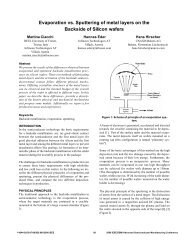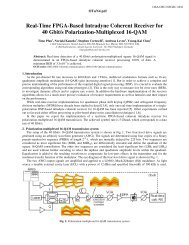Fully-Integrated Polarization-Diversity Coherent Receiver Module for ...
Fully-Integrated Polarization-Diversity Coherent Receiver Module for ...
Fully-Integrated Polarization-Diversity Coherent Receiver Module for ...
Create successful ePaper yourself
Turn your PDF publications into a flip-book with our unique Google optimized e-Paper software.
<strong>Fully</strong>-<strong>Integrated</strong> <strong>Polarization</strong>-<strong>Diversity</strong> <strong>Coherent</strong> <strong>Receiver</strong><br />
<strong>Module</strong> <strong>for</strong> 100G DP-QPSK<br />
1. Introduction<br />
A. Beling, N. Ebel, A. Matiss, and G. Unterbörsch<br />
u2t Photonics AG, Reuchlinstr. 10/11, 10553 Berlin, Germany<br />
Phone: ++49(0)30726113540, Fax: ++49(0)30726113800, E-mail: beling@u2t.de<br />
M. Nölle, J. K. Fischer, J. Hilt, L. Molle, and C. Schubert<br />
Fraunhofer Institute <strong>for</strong> Telecommunications, Heinrich Hertz Institute, Einsteinufer 37, 10587 Berlin, Germany<br />
F. Verluise and L. Fulop<br />
Kylia, 10, rue de Montmorency,75003 Paris, France<br />
Abstract: A new compact coherent receiver module comprising a micro-optic polarization beam<br />
splitter and two InP-based 90 0 hybrids with integrated photodiodes is characterized at 112 Gbit/s<br />
DP-QPSK. A penalty of only 1.3 dB in OSNR sensitivity at a BER of 10 -3 compared to theory was<br />
obtained at C-band wavelengths.<br />
©2010 Optical Society of America<br />
OCIS codes: (060.1660) <strong>Coherent</strong> Communication; (250.3140) <strong>Integrated</strong> optoelectronic circuits<br />
The polarization diverse dual-quadrature coherent receiver is a key component in 100G DP-QPSK long-haul fiber<br />
optic links. In its typical configuration it consists of two polarization beam splitters, two optical 90 hybrids, eight<br />
photodiodes (PDs) and two transimpedance amplifiers. Because of this complexity, a fully-integrated coherent<br />
receiver in one package is highly desirable. It saves footprint, packaging cost and reduces the number of fiber-based<br />
inter-component connections and thus allows <strong>for</strong> a better control of skew. Different degrees of receiver integration<br />
have been published recently including a coherent detector module based on InP-monolithic integration [1], a<br />
monolithic polarization-diversity coherent receiver photonic integrated circuit (PIC) on Si [2], a monolithic InP<br />
multi-wavelength polarization-diversity coherent receiver PIC [3], a dual-polarization coherent receiver module [4],<br />
and a polarization-diversity coherent receiver module with silica-based hybrid integration [5].<br />
In this paper we report on a new compact 100G polarization-diversity coherent receiver module based on hybrid<br />
integration of a free-space micro-optic polarization beam splitter (PBS) with InP PICs. The fully packaged receiver<br />
is successfully operated in a back-to-back experiment with 112 Gbit/s non-return-zero (NRZ) dual-polarization<br />
quadrature phase shift keying (DP-QPSK) signals at 1530 nm, 1550 nm and 1563 nm wavelength.<br />
2. <strong>Polarization</strong>-diversity coherent receiver module<br />
The main building blocks of the receiver are shown in fig. 1. The micro-optic assembly is symmetric <strong>for</strong> both signal<br />
(SIG) and local oscillator (LO) paths and consists of a collimator (C), two half wave plates (HWP), the PBS cube, a<br />
skew compensator (SC) and two micro-lens arrays (L). Whereas the SIG input polarization is arbitrary, the linearly<br />
polarized LO light is launched through the slow axis of the polarization maintaining input fiber (PMF). For<br />
convenience the first HWP is used to ensure 3 dB LO splitting ratio. However, it should be noted that the HWP can<br />
be omitted in future assemblies once the PMF slow axis is aligned correctly with regard to the PBS. To achieve<br />
highest symmetry in both channels, X and Y, a second HWP is integrated in the X channel to per<strong>for</strong>m a TM-to-TE<br />
SIG<br />
LO<br />
HWP<br />
C HWP<br />
PBS<br />
SC<br />
L<br />
L<br />
InP PIC<br />
InP PIC<br />
90° Hybrid<br />
X channel<br />
90° Hybrid<br />
Y channel<br />
Fig. 1. <strong>Coherent</strong> receiver architecture.<br />
OML5.pdf<br />
TIA<br />
TIA<br />
TIA<br />
TIA<br />
XI<br />
XQ<br />
YI<br />
YQ<br />
OSA/OFC/NFOEC 2011<br />
Fig. 2. <strong>Coherent</strong> receiver module. The second fiber pipe is<br />
not used and will be removed in a future package re-design.
conversion. In return and to minimize the channel path length difference a skew compensator (SC) is integrated in<br />
the Y channel. Due to mechanical tolerances we estimated a channel skew of less than 5 ps. The four beams are<br />
finally coupled through micro-lens arrays into the integrated optical spot size converters of the InP-based PICs. Each<br />
of the two PICs comprises a 2x4 multi-mode interference (MMI) coupler 90 hybrid together with four waveguide<br />
pin photodiodes [1]. Four linear differential transimpedance amplifiers (TIAs) are co-packed in the module [4]. The<br />
package with a body size of 27 mm x 40 mm x 6 mm has a coplanar waveguide rf-interface <strong>for</strong> surface mount<br />
assembly of the device (fig.2). The 3 dB bandwidth of the receiver module was 26 GHz as previously reported in<br />
[4].<br />
We measured an average responsivity over all photodiodes of 0.03 A/W at 1550 nm including the 9 dB intrinsic loss<br />
of the PBS and the 2x4 MMI coupler. Fig. 3 shows the polarization extinction ratio (PER) measured <strong>for</strong> all eight<br />
photodiodes versus wavelength using the signal input. A PER of >19 dB was obtained <strong>for</strong> all PDs. A similar result<br />
within 0.4 dB was obtained when using the LO input.<br />
3. DP-QPSK measurement results<br />
OML5.pdf<br />
Fig. 3. PER vs. wavelength in signal path.<br />
The experimental setup <strong>for</strong> the back-to-back characterization of the coherent receiver module in a DP-QPSK system<br />
is shown in fig 4. At the transmitter, an external cavity laser (ECL) followed by a single-drive IQ modulator<br />
(Fujitsu) is used as signal source. The IQ-modulator is driven by the in-phase and quadrature component of a<br />
28 GBd QPSK signal. The bit sequence consists of 2 14 randomly chosen bits, which are generated by a fieldprogrammable<br />
gate array (FPGA) -based real-time transmitter (Tx). After modulation the single polarization signal<br />
passes a polarization multiplexing stage (PMUX), consisting of a coupler, a delay line and a polarization beam<br />
combiner. On the receive side, a variable optical attenuator (VOA) and an erbium doped fiber amplifier (EDFA)<br />
allow <strong>for</strong> varying the optical signal-to-noise ratio (OSNR). After passing the preamplifier and a 10 dB coupler <strong>for</strong><br />
OSNR evaluation the signal is filtered and boosted by a second EDFA. The average optical signal power launched<br />
into the coherent receiver was -5.5 dBm. The light of a second free-running ECL with about 100 kHz linewidth was<br />
used as LO. After amplification and filtering the average optical LO power launched into the coherent receiver was<br />
14.5 dBm. While the state of polarization of the signal light was arbitrary during the experiments, the LO light was<br />
launched into the slow axis of the receiver’s polarization maintaining input fiber. For the experiment the receiver<br />
module was mounted on an adapter board with coaxial rf-interface. Both, photodiodes and TIAs were operated at<br />
3.5 V. A Tektronix 50 GSa/s real-time oscilloscope with 4 channels and 8 bit nominal resolution was used as<br />
analog-to-digital converter (ADC) to capture and digitize the output voltages of the coherent receiver (XI, XQ and<br />
YI, YQ). The digital post-processing was per<strong>for</strong>med offline in a computer. The post-processing includes: resampling<br />
to an integer number of samples per symbol, correction of the 90° hybrid phase errors and imbalance by using the<br />
Gram-Schmidt orthogonalization [6], intra-scope skew correction and FFT based LO offset frequency correction [7].<br />
After that, the two polarization tributaries are separated and the signal clock is recovered by four FIR filters arranged<br />
in a butterfly structure. The corresponding filter coefficients are adapted using the constant modulus algorithm<br />
Fig. 4. Experimental setup <strong>for</strong> back-to-back measurements.<br />
OSA/OFC/NFOEC 2011
(CMA). After pre-convergence the error criterion is switched to the multi-modulus algorithm (MMA) described in<br />
[8] and finally the equalizer is switched to decision directed mode. After equalization, the bits of the individual<br />
tributaries are decoded and errors are counted. Measurements with 112 Gbit/s DP-QPSK modulation <strong>for</strong>mat were<br />
carried out at signal wavelengths of 1530 nm, 1550 nm and 1563 nm. It should be noted that the LO wavelength was<br />
adjusted to the particular signal wavelength to maintain a small frequency difference between signal and LO of a<br />
few MHz. Fig. 5 shows the measured bit-error ratio (BER) vs. OSNR together with a theoretical curve obtained<br />
from [9]. For a BER of 10 -3 an OSNR of 14.6 dB was required at all considered wavelengths. Compared to theory,<br />
this is a penalty of only 1.3 dB. At BER 10 -5 the required OSNR was 18.2 dB at 1550 nm and 1563 nm. However, at<br />
1530 nm wavelength we observed an additional penalty of 0.6 dB at BER 10 -5 which can be attributed partly to<br />
imperfections in the transmitter, filters and in the receiver.<br />
4. Summary<br />
The to-date smallest polarization-diversity coherent receiver module <strong>for</strong> 100G is presented. The receiver is based on<br />
the hybrid integration of free-space micro-optics and InP PICs. It has a high polarization extinction ratio of >19 dB<br />
over the C-band. The receiver was successfully tested in back-to-back system experiments at 112 Gbit/s DP-QPSK.<br />
Compared to theory, we found a penalty of only 1.3 dB in OSNR sensitivity at BER 10 -3 <strong>for</strong> three considered Cband<br />
wavelengths.<br />
5. References<br />
OML5.pdf<br />
Fig. 5. BER vs. OSNR (0.1 nm optical bandwidth) at 112 Gbit/s. The insets<br />
show the constellation diagrams of X and Y channels at OSNR = 19 dB.<br />
[1] H.-G. Bach, A. Matiss, C.C. Leonhardt, R. Kunkel, D. Schmidt, M. Schell, A. Umbach, “Monolithic 90 0 Hybrid with balanced PIN<br />
Photodiodes <strong>for</strong> 100 Gbit/s PM-QPSK receiver applications,” Tech. Digest Optical Fiber Comm. (OFC 2009), San Diego, CA, USA<br />
paper OMK5, 2009.<br />
[2] C. R. Doerr, P. J. Winzer, S. Chandrasekhar, M. Rasras, M. Earnshaw, J. Weiner, D. M. Gill, and Y. K. Chen, “Monolithic Silicon<br />
<strong>Coherent</strong> <strong>Receiver</strong>,“ Tech. Digest Optical Fiber Comm. (OFC 2009), San Diego, CA, USA paper PDPB2, 2009.<br />
[3] C. R. Doerr, L. Zhang, and P. J. Winzer, “Monolithic InP Multi-Wavelength <strong>Coherent</strong> <strong>Receiver</strong>,” Tech. Digest Optical Fiber Comm.<br />
(OFC 2010), San Diego, CA, USA paper PDPB1, 2010.<br />
[4] A. Matiss, R. Ludwig, J.-K. Fischer, L. Molle, C. Schubert, C.C. Leonhardt, H.-G. Bach, R. Kunkel, A. Umbach, “Novel <strong>Integrated</strong><br />
<strong>Coherent</strong> <strong>Receiver</strong> <strong>Module</strong> <strong>for</strong> 100G Serial Transmission,” Tech. Digest Optical Fiber Comm. (OFC 2010), San Diego, CA, USA<br />
paper PDPB3, 2010.<br />
[5] T. Ohyama, I. Ogawa, H. Tanobe, R. Kasahara, S. Tsunashima, T. Yoshimatsu, H. Fukuyama, T. Itoh, Y. Sakamaki, Y. Muramoto,<br />
H. Kawakami, M. Ishikawa, S. Mino, K. Murata, “All-in-one 100-Gbit/s DP-QPSK coherent receiver using novel PLC-based<br />
integration structure with low-loss and wide-tolerance multi-channel optical coupling,” OptoElectronics and Communications<br />
Conference (OECC), 2010 15th , pp.1-2, 5-9 July 2010.<br />
[6] I. Fatadin, S. J. Savory, “Compensation of quadrature imbalance in an optical QPSK coherent receiver,” IEEE Photonics Technol.<br />
Lett., vol. 20, no. 20, pp. 1733-1735, October 2008.<br />
[7] M. Selmi, Y. Jaouën, and Philippe Ciblat, “Accurate digital frequency offset estimator <strong>for</strong> coherent PolMux QAM transmission<br />
systems,” Proc. 35th European Conference on Optical Communication, Vienna, Austria, September 2009, paper P3.08.<br />
[8] H. Louchet; K. Kuzmin; and A. Richter, “Improved DSP algorithms <strong>for</strong> coherent 16-QAM transmission,“ Proc. 34th European<br />
Conference on Optical Communication, Brussels, Belgium, September 2008, paper Tu.1.E.6.<br />
[9] F. Xiong, “Digital Modulation Techniques,” Artech House Inc., Second Edition, 2006.<br />
OSA/OFC/NFOEC 2011











